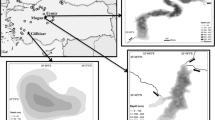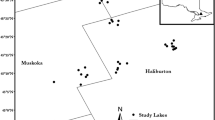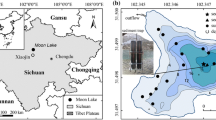Abstract
We examined long-term relationships between Cladocera and limnogeological and climate variables in a late Holocene lake sediment sequence to assess cladoceran responses to climate change and reconstruct past climate variations in southern Finland, near the Baltic Sea coast. Elemental composition, organic matter, and inferred water quality variables were used to constrain paleoenvironmental (until 4500 cal BP) conditions and human impact. Fossil Cladocera assemblages, ephippia, and body size trends were utilized to estimate mean July air temperature (T Jul) variability, open-water season length, and water-temperature regimes. Results revealed stable cladoceran communities, dominated by Eubosmina, until 500 cal BP, followed by major assemblage changes including increases in Chydorus cf. sphaericus, Alonella spp., and Bosmina longirostris. Pb and Cu concentrations were associated temporally with increasing human impact and warming climate during the past few centuries, and were the most significant factors in explaining cladoceran community changes, based on redundancy analysis. A Cladocera-based T Jul reconstruction estimated elevated temperatures for the end of the Holocene Thermal Maximum, a cooler period during ~3000–2000 cal BP, slightly increased temperatures during 1200–800 cal BP corresponding to the Medieval Climate Anomaly (MCA), and lower temperatures during the Little Ice Age (LIA), 800–200 cal BP. The reconstruction also suggests that significant climate warming took place during the twentieth century. Cladocerans mostly associated with warm periods included B. longirostris and Pleuroxus uncinatus, whereas Alona affinis, A. quadrangularis, and C. cf. sphaericus were associated with colder climate. Compared to a reference Chironomidae-inferred T Jul reconstruction from the same region, discrepancies were apparent in amplitude of temperature change, as the temperature variability in the cladoceran-based record was muted until ~200 cal BP. During the LIA, increased ephippia and body size agreed with the temperature reconstruction, but suggested a severely shorter open-water season and reduced water temperatures compared to the preceding late Holocene episodes, even though the cladoceran T Jul showed quite similar temperatures for these periods. Our results suggest that fossil cladoceran assemblages, ephippia, and morphological attributes respond sensitively to long-term climate fluctuations and this record reflects well the major climate events of the late Holocene and provides realistic paleoclimatic estimates for maritime southern Finland.




Similar content being viewed by others
References
Åhlen E, Bystrom P, Korsman T, Persson L, Reinikainen M (2011) Relationships between planktivore community capacity (PCC) and cladoceran microfossils in nothern Swedish lakes. Fundam Appl Limnol 178:315–324
Bigler C, Heiri O, Krskova R, Lotter AF, Sturm M (2006) Distribution of diatoms, chironomids and cladocera in surface sediments of thirty mountain lakes in south-eastern Switzerland. Aquat Sci 68:154–171
Birks HJB, Line JM, Juggins S, Stevenson AC, ter Braak CJF (1990) Diatoms and pH rconstructions. Philos Trans Royal Soc London B 327:263–278
Bjerring R, Becares E, Declerck S, Gross EM, Hansson L-A, Kairesalo T, Nykänen M, Halkiewichz A, Kornijów R, Conde-Porcuna JM, Sereflis M, Nõges T, Moss B, Amsinck SL, Odgaard BV, Jeppesen E (2009) Subfossil Cladocera in relation to contemporary environmental variables in 54 Pan-European lakes. Freshw Biol 54:2401–2417
Brancelj A, Kernan M, Jeppesen E, Rautio M, Manca M, Šiško M, Alonso M, Stuchlík E (2009) Cladocera remains from the sediment of remote cold lakes: a study of 294 lakes across Europe. Adv Limnol 62:269–294
Davidson TA, Sayer CD, Perrow MR, Bramm M, Jeppesen E (2010) The simultaneous inference of zoopkanktivorous fish and macrophyte density from sub-fossil cladoceran assemblages: a multivariate regression tree approach. Freshw Biol 55:546–564
de Bernardi R, Giussani G, Manca M, Ruggiu D (1990) Trophic status and the pelagic system in Lago Maggiore. Hydrobiologia 191:1–8
de Eyto E (2001) Chydorus sphaericus as a biological indicator of water quality in lakes. Verh. Int Verein Limnol 27:3358–3362
Eggermont H, Heiri O (2012) The chironomid-temperature relationship: express in nature and palaeoenvironmental implications. Biol Rev 87:430–456
Flössner D (2000) Die Haplopoda und Cladocera (ohne Bosminidae) Mitteleuropas. Backhuys Publishers, Leiden
Frey DG (1982) Contrasting strategies of gamogenesis in northern and southern populations of Cladocera. Ecology 63:223–241
Green J (1966) Seasonal variation in egg production by Cladocera. J Anim Ecol 35:77–104
Grove JM (2004) Little ice ages: ancient and modern. Routledge, New York
Hammer Ø, Harper DAT, Ryan PD (2001) PAST: paleontological statistics software package for education and data analysis. Palaeontol Electron 4(1). http://palaeo-electronica.org/2001_1/past/issue1_01.htm
Heikkilä M, Seppä H (2003) A 11,000 yr palaeotemperature reconstruction from the southern boreal zone in Finland. Quat Sci Rev 22:541–554
Heikkilä M, Edwards TWD, Seppä H, Sonninen E (2010) Sediment isotope tracers from Lake Saarikko, Finland, and implications for Holocene hydroclimatology. Quat Sci Rev 29:2146–2160
Heiri O, Brooks SJ, Renssen H, Bedford A, Hazekamp M, Ilyashuk B, Jeffers ES, Lang B, Kirilova E, Kuiper S, Millet L, Samartin S, Toth M, Verbruggen F, Watson JE, van Asch N, Lammertsma E, Amon L, Birks HH, Birks HJ, Mortensen MF, Hoek WZ, Magyari E, Muñoz Sobrino C, Seppä H, Tinner W, Tonkov S, Veski S, Lotter AF (2014a) Validation of climate model-inferred regional temperature change for late-glacial Europe. Nat Commun 5:4914. doi:10.1038/ncomms5914
Heiri O, Koinig KA, Spötl C, Barrett S, Brauer S, Drescher-Schneider R, Gaar D, Ivy-Ochs S, Kerschner H, Luetscher M, Moran A, Nicolussi K, Preusser F, Schmidt R, Schoeneich P, Schwörer C, Sprafke T, Terhorst B, Tinner W (2014b) Palaeoclimate records 60e8 ka in the Austrian and Swiss Alps and their forelands. Quat Sci Rev 106:186–205
Helama S, Meriläinen J, Tuomenvirta H (2009) Multi-centennial megadrought in northern Europe coincided with a global El NiñoeSouthern oscillation drought pattern during the medieval climate anomaly. Geology 37:175–178
Hofmann W (2000) Response of the chydorid faunas to rapid climate changes in four alpine lakes at different altitudes. Palaeogeogr Palaeoclimatol Palaeoecol 159:281–292
Jeppesen E, Madsen EA, Jensen JP, Anderson NJ (1996) Reconstructing the past density of planktivorous fish and trophic structure from sedimentary zooplankton fossils: a surface sediment calibration data set from shallow lakes. Freshw Biol 36:115–127
Jeppesen E, Meerhoff M, Davidson TA, Trolle D, Søndergaard M, Lauridsen TL, Beklioğlu M, Brucet S, Volta P, González-Bergonzoni I, Nielsen A (2014) Climate change impacts on lakes: an integrated ecological perspective based on a multi-faceted approach, with special focus on shallow lakes. J Limnol 73:88–111
Jeziorski A, Keller B, Paterson AM, Greenaway CM, Smol JP (2013) Aquatic ecosystem responses to rapid recovery from extreme acidification and metal contamination in lakes near Wawa, Ontario. Ecosystems 16:209–223
Kamenik C, Szeroczyńska K, Schmidt R (2007) Relationship among recent Alpine Cladocera remains and their environment: implications for climate-change studies. Hydrobiologia 594:33–46
Kattel GR, Battarbee RW, Mackay A, Birks HJB (2008) Recent ecological change in a remote Scottish mountain loch: an evaluation of a Cladocera-based temperature transfer-function. Palaeogeogr Palaeoclimatol Palaeoecol 259:51–76
Korhola A (1999) Distribution patterns of Cladocera in subarctic Fennoscandian lakes and their potential in environmental reconstruction. Ecography 22:357–373
Korosi JB, Paterson AM, DeSellas AM, Smol JP (2008) Linking mean body size of pelagic Cladocera to environmental variables in Precambrian Shield lakes: a paleolimnological approach. J Limnol 67:22–34
Korosi JB, Kurek J, Smol JP (2013) A review on utilizing Bosmina size structure archived in lake sediments to infer historic shifts in predation regimes. J Plankton Res 35:444–460
Korponai J, Magyari EM, Buczkó K, Iepure S, Namiotko T, Czakó D, Kövér C, Braun M (2011) Cladocera response to late glacial to early Holocene climate change in a South Carpathian mountain lake. Hydrobiologia 676:223–235
Kujala A-M (2011) Mapping of the headwaters and small lakes in Östersundom, Helsinki. Master’s thesis, University of Helsinki, Helsinki
Kultti S, Nevalainen L, Luoto TP, Sarmaja-Korjonen K (2011) Subfossil chydorid (Cladocera, Chydoridae) ephippia as paleoenvironmental proxies: evidence from boreal and subarctic lakes in Finland. Hydrobiologia 676:23–37
Labaj AL, Kurek J, Jeziorski A, Smol JP (2015) Elevated metal concentrations inhibit biological recovery of Cladocera in previously acidified boreal lakes. Freshw Biol 60:347–359
Lepš J, Šmilauer P (2003) Multivariate analysis of ecological data using CANOCO. Cambridge University Press, Cambridge
Lotter AF, Birks HJB, Eicher U, Hofmann W, Schwander J, Wick L (2000) Younger Dryas and Allerød summer temperatures at Gerzensee (Switzerland) inferred from fossil pollen and cladoceran assemblages. Palaeogeogr Palaeoclimatol Palaeoecol 159:349–361
Luoto TP (2013) How cold was the Little Ice Age? A proxy-based reconstruction from Finland applying modern analogues of fossil midge assemblages. Environ Earth Sci 68:1321–1329
Luoto TP, Helama S (2010) Palaeoclimatological and palaeolimnological records from fossil midges and tree-rings: the role of the North Atlantic Oscillation in eastern Finland through the Medieval Climate Anomaly and Little Ice Age. Quat Sci Rev 29:2411–2423
Luoto TP, Salonen V-P (2010) Fossil midge larvae (Diptera: Chironomidae) as quantitative indicators of late-winter hypolimnetic oxygen in southern Finland: a calibration model, case studies and potentialities. Boreal Env Res 15:1–18
Luoto TP, Nevalainen L, Sarmaja-Korjonen K (2008) Multiproxy evidence for the ‘Little Ice Age’ from Lake Hampträsk, southern Finland. J Paleolimnol 40:1097–1113
Luoto TP, Sarmaja-Korjonen K, Nevalainen L, Kauppila T (2009) A 700 year record of temperature and nutrient changes in a small eutrophied lake in southern Finland. Holocene 19:1063–1072
Luoto TP, Kultti S, Nevalainen L, Sarmaja-Korjonen K (2010) Temperature and effective moisture variability in southern Finland during the Holocene quantified with midge-based calibration models. J Quat Sci 25:1317–1326
Luoto TP, Nevalainen L, Kultti S, Sarmaja-Korjonen K (2011) An evaluation of the influence of water depth and river inflow on quantitative Cladocera-based temperature and lake level inferences in a shallow boreal lake. Hydrobiologia 676:143–154
Manca M, Comoli P (1995) Temporal variations of fossil Cladocera in the sediments of Lake Orta (N. Italy) over the last 400 years. J Paleolimnol 14:113–122
Manca M, Comoli P (2004) Reconstructing long-term changes in Daphnia’s body size from subfossil remains in sediments of a small lake in the Himalayas. J Paleolimnol 32:95–107
Manca M, Torretta B, Comoli P, Amsinck SL, Jeppesen E (2007) Major changes in trophic dynamics in large, deep sub-alpine Lake Maggiore from 1940s to 2002: a high resolution comparative palaeo-neolimnological study. Freshw Biol 52:2256–2269
Nevalainen L (2011) Intra-lake heterogeneity of sedimentary cladoceran (Crustacea) assemblages forced by local hydrology. Hydrobiologia 676:9–22
Nevalainen L, Luoto TP (2012) Faunal (Chironomidae, Cladocera) responses to post-Little Ice Age climate warming in the high Austrian Alps. J Paleolimnol 48:711–724
Nevalainen L, Luoto TP (2013) Limnological deterioration forces community and phenotypic changes in Cladocera: tracking eutrophication of Mallusjärvi, a lake in southern Finland. Boreal Env Res 18:209–222
Nevalainen L, Luoto TP, Kultti S, Sarmaja-Korjonen K (2012) Do subfossil Cladocera and chydorid ephippia disentangle Holocene climate trends? Holocene 22:291–299
Nevalainen L, Helama S, Luoto TP (2013a) Hydroclimatic variations over the last millennium in eastern Finland disentangled by fossil Cladocera. Palaeogeogr Palaeoclimatol Palaeoecol 378:13–21
Nevalainen L, Luoto TP, Kultti S, Sarmaja-Korjonen K (2013b) Spatio-temporal distribution of sedimentary Cladocera (Crustacea: Branchiopoda) in relation to climate. J Biogeogr 40:1548–1559
Nevalainen L, Ketola M, Korosi JB, Manca M, Kurmayer R, Koinig K, Psenner R, Luoto TP (2014) Zooplankton (Cladocera) species turnover and long-term decline of Daphnia in two high mountain lakes in the Austrian Alps. Hydrobiologia 722:75–91
Nykänen M, Malinen T, Vakkilainen K, Liukkonen M, Kairesalo T (2010) Cladoceran community responses to biomanipulation and re-oligotrophication in Lake Vesijärvi, Finland, as inferred from remains in annually laminated sediment. Freshw Biol 55:1164–1181
Overpeck JT, Webb T, Prentice IC (1985) Quantitative interpretation of fossil pollen spectra: dissimilarity coefficients and the method of modern analogs. Quat Res 23:87–108
Rantala MV (2013) Biostratigraphical and geochemical evidence for late Holocene water quality and limnoecological changes in a small humic lake in southern Finland. MSc thesis, Department of Geosciences and Geography, University of Helsinki
Rantala MV, Luoto TP, Nevalainen L (2015) Late Holocene changes in the humic state of a boreal lake and their associations with organic matter transport and climate dynamics. Biogeochem 123:63–82
Rautio M, Nevalainen L (2013) Cladocera. In: Elias SA (ed) Encyclopedia of quaternary science. Elsevier, Amsterdam, pp 271–280
Salonen V-P, Tuovinen N, Valpola S (2006) History of mine drainage impact on Lake Orijärvi algal communities, SW Finland. J Paleolimnol 35:289–303
Sarmaja-Korjonen K (2002) Multi-proxy data from Kaksoislammi Lake in Finland: dramatic changes in the late Holocene cladoceran assemblages. J Paleolimnol 28:287–296
Sarmaja-Korjonen K (2004) Chydorid ephippia as indicators of environmental change: a new method. Hydrobiologia 526:129–136
Sarmaja-Korjonen K, Seppä H (2007) Abrupt and consistent responses of aquatic and terrrestrial ecosystems to the 8200 cal yr BP cold event—a lacustrine record from Lake Arapisto, Finland. Holocene 17:457–467
Sarmaja-Korjonen K, Szeroczyńska K, Gasiorowski M (2003) Subfossil chydorid taxa and assemblages from lake sediments in Poland and Finland with special reference to climate. Studia Quat 20:25–34
Szeroczyńska K, Sarmaja-Korjonen K (2007) Atlas of subfossil Cladocera from central and northern Europe. Friends of the Lower Vistula Society, Świecie
ter Braak CJF, Smilauer P (2002) CANOCO reference manual and CanoDraw for Windows user’s guide: software for canonical community ordination (version 4.5). Microcomputer Power, Ithaca
Visbeck MH, Hurrell JW, Polvani L, Cullen HM (2001) The North Atlantic Oscillation: past, present, and future. Proc Natl Acad Sci USA 98:12876–12877
Wanner H, Beerb J, Bütikofer J, Crowley TJ, Cubasch U, Flückiger J, Goosse H, Grosjean M, Joos F, Kaplan JO, Küttel M, Müller SA, Prentice IC, Solomina O, Stocker TF, Tarasov P, Wagner M, Widmann M (2008) Mid-to Late Holocene climate change: an overview. Quat Sci Rev 27:1791–1828
Zawiska I, Słowiński M, Correa-Metrio A, Obremska M, Luoto TP, Nevalainen L, Woszczyk M, Milecka K (2015) The response of a shallow lake and its catchment to Late Glacial climate changes—A case study from eastern Poland. Catena 126:1–10
Acknowledgments
This study was funded by projects VIOLET (Academy of Finland, Grant #287547) and LASSE (City of Helsinki Environment Centre, Maa- ja vesitekniikan tuki ry, University of Helsinki Alumni Association Fund), and the Doctoral Program in Geosciences of the University of Helsinki. We thank Dr. Oliver Heiri and two anonymous reviewers for their constructive comments on the manuscript.
Author information
Authors and Affiliations
Corresponding author
Rights and permissions
About this article
Cite this article
Nevalainen, L., Rantala, M.V. & Luoto, T.P. Sedimentary cladoceran assemblages and their functional attributes record late Holocene climate variability in southern Finland. J Paleolimnol 54, 239–252 (2015). https://doi.org/10.1007/s10933-015-9849-z
Received:
Accepted:
Published:
Issue Date:
DOI: https://doi.org/10.1007/s10933-015-9849-z




